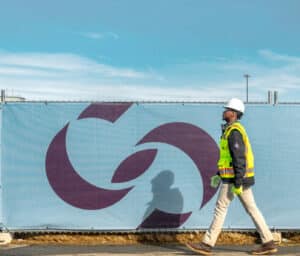
Boston-based construction giant Suffolk and Cambridge AI firm Smartvid are using predictive analytics to reduce injury risks on job sites. Photo courtesy of Suffolk Construction | Lou Jones
Say hello to Vinnie, an emerging soothsayer star of the construction industry.
Arriving as soon as this fall, Vinnie is expected to be able to predict when construction industry workers are about to engage in particularly risky behavior that may lead to serious work site injuries.
Vinnie won’t be using a crystal ball, tarot cards or palm-reading techniques to predict the future. Instead, he’ll be using artificial intelligence: Vinnie is the nickname of an AI-powered “predictive” technology now being developed by Cambridge-based Smartvid.io, with the backing of local companies such as Boston-based construction companies Suffolk and Shawmut Design and Construction, among other firms.
Using millions of work site statistics and photos provided by construction companies, Smartvid.io is developing algorithms designed to detect and warn officials about risky scenarios ahead for construction workers, from potential falls from ladders to lacerations suffered while working on certain types of equipment on certain days.
“It’s sort of like Moneyball,” said Josh Kanner, founder of Smartvid, referring to the Michael Lewis book about the Oakland Athletics’ sabermetric approach for assembling a baseball roster based on players’ statistical records. “We’re hoping to use metrics being developed to transform the construction industry, just like how Moneyball re-invented baseball.”
Based on Tech in Use
If all goes well with Vinnie’s ability to predict safety-related incidents, the hope is that the same technology eventually can be used to predict other risky aspects of the construction industry, such as quality risks, cost risks and scheduling risks associated with both big and small projects.
“We’re pretty confident [the technology] will work,” says Jit Kee Chin, executive vice president and chief data and innovation officer at Suffolk, which is providing SmartVid with years of data and photo imagery that Vinnie will process to arrive at its “predictive” conclusions. “We’ve already done the R&D, so it should be ready [for full deployment] soon.”
Indeed, Vinnie has already been a success – or, rather, “Vinnie 1.0.” The initial Vinnie, currently in use by about 50 companies globally, is an “observation” tool that can, via advanced image recognition technology, detect risky scenarios as they unfold, or look back at incidents to determine what led to injuries.
Suffolk’s Chin says that Suffolk once noticed an uptick at one construction site in the number of hand lacerations suffered by workers. Vinnie 1.0 analyzed photos, now regularly taken during construction hours at large building sites, and determined that at certain times of the day workers tended to take their gloves off. The gloves-off practice was stopped – and the hand lacerations declined.
40 Percent Drop in Injuries
Les Hiscoe, chief executive of Shawmut Construction and Design, said his company was an “early, early adopter” of Smartvid’s “observation” technology and is a big believer in its benefits.
“We’re now using Smartvid’s [technology] on all our projects around the country. It’s all about data,” Hiscoe said. “Data is the key.”
Shawmut Design and Construction saw an approximate 40 percent reduction in total OSHA recordable injury rates from 2018, when Shawmut first started using the product, to 2019.
Shawmut saw an approximate 40 percent reduction in total OSHA–recordable injury rates from 2018, when Shawmut first started using the product, to 2019. That includes all subcontractor and Shawmut performances combined.
At Suffolk, Chin says Vinnie 1.0 “definitely helped reduce” OSHA–recordable injuries, with the company’s injury rate falling by more than 30 percent from 2018 to 2019.
The success of Vinnie 1.0 led to the logical question: If the AI technology could analyze and pinpoint potential problems in real-time – or sift through data and images to pinpoint the likely causes of past incidents – why not attempt to develop a predictive version?
The idea: Compile all injury-related data and images dating back years, sort the information into injury categories such as falls, cuts, electrocutions, getting hit or crushed by equipment or materials, and then sort them again by other factors including weather, water and snow buildups, heights at which workers operate, the types of tools and equipment used.
Industry Pools Data
So confident that the predictive technology will work, Smartvid and Suffolk recently helped form the new Predictive Analytics Strategic Council, which already has about 15 members, most of them constructions companies, such as Suffolk and Shawmut, along with construction industry insurers and insurance brokers, such as AON.
There’s one hard requirement for every new member: They must contribute their work-safety data and work-site photos in order to help develop the new “predictive” technology.
“We’ve found a lot of interest from other companies,” said Chin of the new council. “The mission of the council is to learn.”
Both Chin and Shawmut’s Hiscoe emphasized that the Vinnie technology is only one component of work-place safety policies and procedures.
“But [Smartvid’s] technology helps guide us to more quickly detect and intervene in problems,” he said. “It’s another level of that safety stack.”
“I still comes down to human behavior,” said Chin. “The technology ultimately helps humans to reduce risks.”




 |
| 

